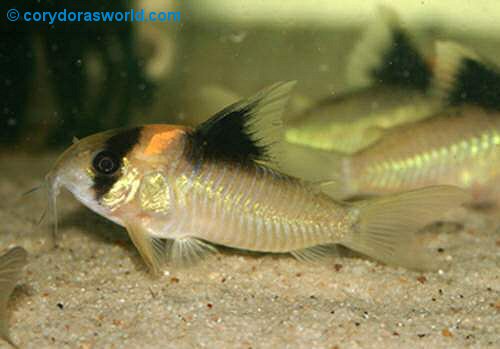1 have had a pair of H.
burgessi for approximately 5 years, they were
mistakenly labeled as H. adolfoi in a shop
in Romford, Essex. The female at the time was about
50mm (TL) so at a conservative estimate she must
be now around 6 to 7 years old. 1also came across
my six other fish by accident. About 2 years ago
Wholesale Tropicals at Bethnal Green imported several
boxes of H. adolfoi, and one day while looking
through the tank in the shop, 1 found these H.
burgessi and a lone Brochis imitator
in amongst the H. adolfoi. Fortunately the
six fish turned out to be 3 pairs. Eventually all
eight fish were placed in a 24 x 15 x 18 tank which
was filtered by an Eheim internal filter and decorated
with bogwood and Java fern. Here they stayed in
the back bedroom of my house until my fish house
was completed in mid January this year (1994). At
this time 1 moved this and many other tanks outside.
The basic set up remained the same except that the
Java fern has been removed from the tank.
On the 2nd of February this
year whilst in the fish house 1 became aware of
an increased activity in the H. burgessi
tank. On having a quick look 1 found about 8 - 12
eggs stuck to the glass in the far left hand corner
of the tank. The fish spawned as four pairs each
male appearing to chase "his own female"
around the tank before coming together in the usual
'T' position. Each female would carry 1 and on occasions
2 eggs in her ventral fins and the eggs were placed
in either the corners of the tank or around the
rim of the live food bowl at the front of the tank.
From the first spawning
1 removed 105eggs which were placed into a small
heated tank of filtered rain water. The tank was
filtered by a small sponge filter and a drop of
Myxazin was added to try and reduce the number of
eggs becoming fungussed. Of these eggs approximately
70 were fertile and at a temperature of 78' ~ 79'
F the eggs hatched in 3 to 4 days.
The first food for the fry
was liquifry for the first 2 days followed by microworm
and Aquarian fry food. After about day seven 1 started
to lose quite a number of fry, which 1 have put
down to the fish not getting enough "substantial"
food early enough. As a result subsequent spawnings
now receive newly hatched Brine Shrimp at about
day 4 and fortunately this problem, has not reoccurred.
From this first spawning 1 raised 35 fry. For growth
they were fed 3 to 4 times a day. This normally
consisted of Brine Shrimp, flake and frozen Bloodworm
and when slightly larger chopped live Tubifex worms.The
growth rate of H. burgessi is far quicker
than H. adolofi, which as any aquarist who
has spawned them knows is painfully slow. But it
doesn't seem to be a species that races away in
the growth stakes. On this point about 2 weeks after
this first spawning a group of Corydoras ellisae
spawned for me. This species which lays eggs of
only 1 mm in size have produced fry which have passed
H. burgessi in size despite it's 2 week head
start.
The tap water in the part
of Kent where 1 live runs at about 7.2 - 7.5 pH
with a 15 - 18 GH hardness and the fish spawned
at a temperature of 77' F. At the time of writing
the C. burgessi are spawning about every
7 - 14 days and on average they are producing between
20 - 50 eggs per spawning. The average size of the
broods raised are about 75% of the eggs laid. Furthermore
they do not appear to favour a particular time of
day to spawn. I have observed them spawning during
morning, afternoons and evenings and have even found
eggs that have been laid over night.
This Article first appeared
in the Catfish Association of Great Britain Newsletter
in the third issue of 1994.
Lineage:
Placed in Lineage 9, the "short-snouted"
species with the designated type species: C.
punctatus. A revision in the future would constitute
the resurrection of the genus name Hoplisoma
(Agassiz, 1846). As
of the latest revision (Dias
et al 2024) Corydoras burgessi
has now been placed in Lineage 9 and has the new
genus name of Hoplisoma.
Photo Credit: ©
Ian Fuller @



